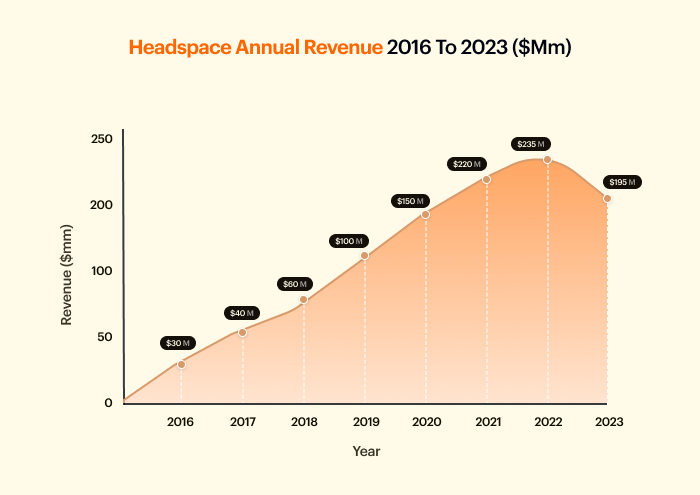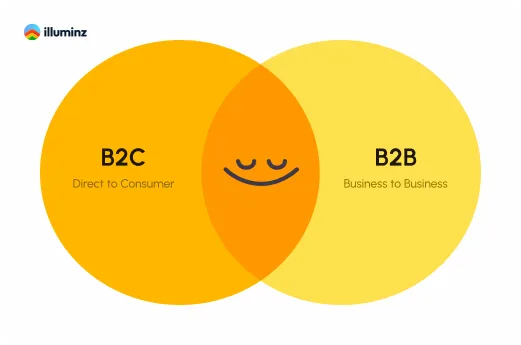Introduction
Every time we seek a moment of peace in our busy lives, we often turn to meditation. It's a universal need, Right? but it should be done correctly?

Headspace, a leading meditation and mindfulness app, has make it possible. It hasn't just participated in the wellness market; it has revolutionized it.
But the thing is, when you search for a meditation app on Google Play or the Apple Store, you're met with hundreds of options. So, how does Headspace make money and manage to stand out? Let's find out.
What Stats Say About Headspace
- Revenue: In 2023, Headspace achieved an estimated revenue of $195 million.
- Subscribers: The app boasts 2.8 million subscribers.
- Downloads: Headspace has been downloaded 80 million times.
- Corporate Partnerships: 2,700 businesses have partnered with Headspace, providing the app for free to their employees.
- Valuation: Headspace Health, the combined entity of Headspace and Ginger, is valued at $3 billion.
Headspace annual revenue 2016 to 2023 ($mm)

What is Headspace?
Headspace, a mindfulness and meditation app, was created in 2010 by co-founders Andy Puddicombe, a former monk, and Richard Pierson. Their mission was to help as many people as possible realize the benefits of meditation. Headspace aims to reduce stress, improve sleep, develop healthy habits, and enhance overall well-being.
In 2023, the Headspace app generated an impressive estimated revenue of $195 million, highlighting its significant impact and popularity in the wellness market.
Business Model of Headspace
Headspace’s business model most closely resembles a subscription business model. Subscription business models work by offering a product or service that customers pay for regularly, creating steady revenue.
The Headspace revenue model is divided into two distinct business fields: the consumer channel (through the app) and B2B solutions (corporate wellness schemes).

B2C: Direct to Consumer
Subscription Services: The core of Headspace's B2C model is its subscription service, allowing individuals to purchase monthly or annual plans. This subscription grants continuous access to Headspace's full range of offerings, including guided meditations, sleep aids, and mindfulness exercises. As of 2023, Headspace boasts an impressive 2.8 million subscribers.
Freemium Model: Headspace also operates on a freemium model, offering limited free content to attract users and give them a taste of what the app provides. This strategy encourages users to upgrade to a paid subscription to access more comprehensive content.
B2B: Business to Business
Corporate Wellness Programs: Headspace offers customized programs aimed at enhancing employee wellness. These programs are integrated into companies' benefits packages, providing employees with free or discounted access to the app. This not only helps in employee retention but also boosts productivity and reduces workplace stress.
Healthcare Partnerships: Recognizing the importance of mental health, Headspace collaborates with healthcare providers and institutions to offer its services as part of therapeutic treatments, wellness programs, or patient care.
This integration into the healthcare ecosystem extends its market reach and reinforces its credibility in the wellness space.
Key Challenges for Headspace
Headspace, despite its success and popularity in the digital wellness arena, faces several challenges. Addressing these can be crucial for its sustained growth and market leadership. Here are some of the key challenges:
Market Saturation
The mindfulness and meditation app market is becoming increasingly crowded, with numerous apps offering similar services. This saturation leads to intense competition, not only in attracting new users but also in retaining them. Headspace needs to continually innovate and differentiate its offerings to stay ahead of competitors like Calm, Insight Timer, and others.
User Retention
While acquiring new users is challenging, retaining them is an even more difficult. Many users download wellness apps with good intentions but may not stick around long enough to convert to paying subscribers. Ensuring ongoing engagement and demonstrating continuous value are crucial for maintaining a solid user base.
Pricing Pressure
The presence of free alternatives and cheaper services puts pressure on Headspace to justify its subscription price. Users are increasingly price-sensitive, especially in a market where many apps offer free features. Headspace must balance pricing with value offered to prevent users from switching to more affordable options.
Data Privacy Concerns
As a digital platform collecting sensitive user data, including mental health information and personal preferences, Headspace must navigate the complexities of data privacy. Users are becoming more aware and concerned about how their personal data is handled and protected. Ensuring robust data security measures and transparent data usage policies are vital to maintaining user trust.
Expanding Demographic Reach
While Headspace has a broad user base, expanding its reach to include more diverse demographics can be challenging. Different groups may require tailored content that addresses specific cultural or socio-economic backgrounds, expanding the app’s inclusivity and accessibility.
Headspace Growth strategy

Onboarding: Driving Activation, Engagement, and Retention
Headspace places a strong emphasis on the onboarding process to ensure users quickly see the value of the app. This phase is critical in driving activation, where new users are encouraged to engage with personalized meditation sessions. Engagement is maintained through reminders and progress tracking, which help integrate Headspace into daily routines, ultimately boosting long-term retention.
A Deep Focus on Simplicity: Lessons on Endless Optimization
Headspace has mastered the art of simplicity in its user interface and overall user experience. The app continually optimizes its features to ensure they are user-friendly and effective. This sometimes means taking away features that complicate the user experience or dilute the core value proposition. Such a focus on simplicity ensures that users have a seamless and enriching experience every time they interact with the app.
Content Marketing and SEO as a Growth Engine
Headspace Attracts 8 Million Leads per Year Through Content Clusters. Headspace invests in high-quality, SEO-optimized content that addresses common questions and challenges related to mental health and wellness. This content drives organic traffic to their site and also establishes Headspace as a thought leader in the wellness domain. Blogs, guided meditation samples, and user testimonials are all part of the content strategy that attracts new users and re-engages existing ones.
From D2C to B2B
The introduction of Headspace for Work, which offers tailored programs for employee wellness, exemplifies this shift. This B2B approach not only broadens the user base but also stabilizes revenue through corporate subscriptions and partnerships.
Technological Integration and UX
Headspace invests heavily in integrating the latest technologies to enhance the user experience and maintain a competitive edge. Utilizing data analytics, artificial intelligence, and machine learning, the app personalizes meditation experiences and makes insightful recommendations based on user behavior and preferences. This focus on technology improves functionality and user engagement by providing a highly customized and intuitive user experience.
Conclusion
Headspace’s success is due to its holistic approach, combining strong branding, user-focused design, technological innovation, diverse content offerings, strategic partnerships, scientific backing, effective marketing strategies, and expansion into new markets. These elements come together to create a platform that effectively meets the growing demand for digital wellness tools, helping it to "win the game" in a competitive landscape.
Frequently Asked Questions on Headspace
Ques: How does Headspace attract and retain users?
Ans: Headspace uses a freemium model, personalized meditation sessions, and a seamless onboarding process to engage users and encourage long-term retention.
Ques: How does Headspace ensure its app remains user-friendly?
Ans: Headspace focuses on simplicity and continuous optimization, removing features that complicate the user experience and ensuring a seamless interaction.
Ques: How can I create an app like Headspace?
Ans: If you’re interested in creating a revolutionary app like Headspace, contact us at illuminz. We specialize in developing innovative digital solutions that transform industries. Let’s start your journey towards creating impactful, user-friendly applications.

